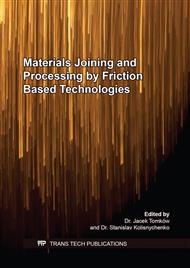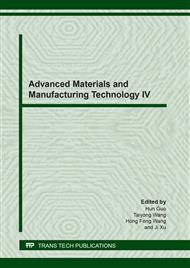[1]
G. Lv. Study on Lightweight of a Certain Aircraft Parts Based on Composite Materials [D]. Changchun: Jilin University, (2013).
Google Scholar
[2]
H. Zheng, X.Y. Zhao. Lightweight Automobile and Application of Aluminum Alloys in Modern Automobile Production [J]. Forging and Stamping Technology, 2016, 41(2): 1-5.
Google Scholar
[3]
Y. Zeng, Z.M. Yin, Q.L. Pan, Z.Q. Zheng, Z.Y. Liu. Present Research and Developing Trends of Ultra High Strength Aluminum Alloys [J]. Journal of Central South University of Technology (Natural Science), 2002, 33(6): 592-596.
Google Scholar
[4]
W.M. Zhuang, Z. Hu, L.L. Liang. Lightweight Design of AA7075 B-Pillar Based on Side Impact Crashworthiness [J]. Automobile Technology, 2016, (10): 1-6.
Google Scholar
[5]
F.G. Cong, G. Zhao, N. Tian, X. Han, M.X. Zhu, J.H. Y. Research Progress and Development Trend of Strengthening-toughening of Ultra-high Strength 7 × × × Aluminum Alloy [J]. Light Alloy Fabrication Technology, 2012, 40(10): 23-33.
Google Scholar
[6]
H.M. Liu, Z.D. Song, P. Xu, J. Zhang. Experimental Study of the Wear Resistance of TiC/7075 Al Matrix Composite [J]. Journal of Materials Engineering, 2011, (7): 66-69.
Google Scholar
[7]
C. Lin. Effect of Aging Time on Friction and Wear Properties of 7075 Aluminum Alloy [J]. China Science and Technology Information, 2012, (24): 50.
Google Scholar
[8]
K.J. Huang, X. Lin, C.W. Li, C.S Xie. Microstructure and Wear Behavior of Laser Cladding Zr-based Composite Coatings on AA7075 Aluminum Alloy [J]. Applied Laser, 2006, 26(6): 398-400.
Google Scholar
[9]
M. Sun, C.G. Xu, J.P. He, F. Wang, X.L. Zhou, B. Yang. Tensile and Wear Properties of TiC/7075 Composite Prepared by Melt in-Situ Synthesis [J]. Rare Metal Materials and Engineering, 2009, 38(2): 308-312.
Google Scholar
[10]
P. Xu, Y.Q. Wang, Z.D. Song, H.M. Liu. Effect of In-situ TiC Particles on Microstructure and Wear Properties of 7075 Aluminum Alloy [J]. Light Alloy Fabrication Technology, 2011, 39(2): 55-59.
Google Scholar
[11]
Y. Li, H. Yan, Z. Hu, S.M. Yang. Study on Wear Properties of Al3Ti/7075 Aluminum Matrix Composites [J]. Forging and Stamping Technology, 2011, 36(5): 124-127.
Google Scholar
[12]
L.S Zuo, D.W. Zuo, Y.C. Zhu, H.F. Wang. Effect of Process Parameters on Surface Topography of Friction Stir Welding [J]. International Journal of Advanced Manufacturing Technology, 2018. 98(5-8): 1807-1816.
DOI: 10.1007/s00170-018-2326-x
Google Scholar
[13]
L.S Zuo, D.W. Zuo, Y.C. Zhu, H.F. Wang. International Journal of Advanced Manufacturing Technology, 2018, https://doi.org/10.1007/s00170-018-2565-x.
Google Scholar
[14]
J.L. Wu, K.S. Wang, L.H. Zhou, W. Wang. Development of Friction Stir Processing [J]. Hot Working Technology, 2010, 39(9): 150-153.
Google Scholar
[15]
P. Zhang, Y.C. Zhai, Y.Q. Wang. Friction, Wear and Surface Quality of 7055 Aluminum Alloy under Extreme Conditions [J]. Tribology, 2016, 36(2): 254-260.
Google Scholar
[16]
S.X. Li, Z.W. Liu. Influence of Temperature on Friction and Wear Behavior of 6061 Aluminum Alloy [J]. Materials for Mechanical Engineering, 2016, 40(1): 20-24.
Google Scholar
[17]
J.P Yu, X.H. Cui, S.Q. Wang. Study on Dry Sliding Wear Behavior of 7075 Aluminum Alloy [J]. Nonferrous Metals Engineering, 2013, 3(5): 18-20.
Google Scholar
[18]
A. Baradeswaran, A.E. Perumal. Study on Mechanical and Wear Properties of Al 7075/Al2O3/graphite Hybrid Composites [J], Composites: Part B, 2014, 56(1): 464-471.
DOI: 10.1016/j.compositesb.2013.08.013
Google Scholar
[19]
C.M. Rejil, I. Dinaharan, S.J. Vijay, N. Murugan. Microstructure and Sliding Wear Behavior of AA6360/(TiC+B4C) Hybrid Surface Composite Layer Synthesized by Friction Stir Processing on Aluminum Substrate [J]. Materials Science and Engineering: A, 2012, 552(4): 336-344.
DOI: 10.1016/j.msea.2012.05.049
Google Scholar



